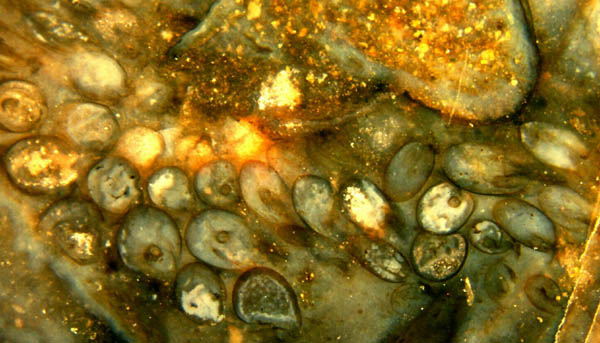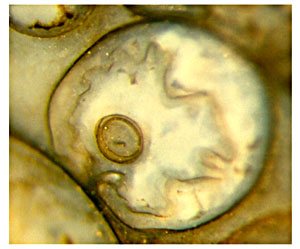Ebullitiocaris
- a slothful little creature that
comes in flocks
 One
of the less common sights in the Rhynie chert is a dense cluster of
dozens of mm-size oval objects superficially looking like as many
sheep. These objects have been recognized
only
recently as crustaceans [1] and tentatively put into the cladoceran
clade, which means they are related to the common water fleas. Unlike
the latter, which seem to be in perpetual motion, Ebullitiocaris led
a
virtually sessile life, clinging to plant debris and possibly grazing
on algal mats, a behaviour also known from various extant water flea
relatives. The fossils do not show much detail
except for a segmented tube inside
(Fig.2).
One
of the less common sights in the Rhynie chert is a dense cluster of
dozens of mm-size oval objects superficially looking like as many
sheep. These objects have been recognized
only
recently as crustaceans [1] and tentatively put into the cladoceran
clade, which means they are related to the common water fleas. Unlike
the latter, which seem to be in perpetual motion, Ebullitiocaris led
a
virtually sessile life, clinging to plant debris and possibly grazing
on algal mats, a behaviour also known from various extant water flea
relatives. The fossils do not show much detail
except for a segmented tube inside
(Fig.2).

Fig.1: Flock of the freshwater crustacean Ebullitiocaris among
plant debris in Rhynie chert. Width of the picture 8mm.
Fig.2: Ebullitiocaris
with a segmented tube as the
only distinct feature seen inside. Width of the picture 1mm.
Fig.3
(below): Ebullitiocaris
with concentric rings
as
evidence for the non-spiral structure of the tube inside. The
deformation by contact with another specimen below left indicates that
the shell was soft. Width of the picture 0.82mm.

The authors in [1] favour a tentative interpretation of this
tube as the gut, which requires the assumption that “the apparently
segmented appearance of the tube is actually caused by
the line of section cutting through the three-dimensional spiralling
structure of the gut.”
The alleged spiral structure serves as an argument in favour of the
water flea connection. However, the pictures in [1] do rather not
suggest a spiral structure,
neither do the specimens in our sample. The tube, or at least part of
it, seems to be really composed of short segments like plumbers’
fittings (Fig.3), with a ribbon-like cord inside (Figs. 2,3), which
excludes an interpretation as the gut.
Apparently in anticipation of evidence contradicting the spiral
assumption, the authors [1] discussed the implication of a segmented
structure, too: It would place Ebullitiocaris
halfway between
conchostracans and cladocerans, as a basal link, and thus give it
greater importance than originally thought.
H.-J. Weiss
2006
[1] L.
Anderson et al.: A new univalve crustacean from the
Early Devonian Rhynie chert hot-spring complex,
Trans. Roy. Soc. Edinburgh, Earth
Sciences 94(2004 for 2003), 355-369.
Annotation (2010): Ebullitiocaris
is erroneously called rotifer in "Paleobotany". See chapter Errors and
Mistakes.
 |
 |
12 |


 One
of the less common sights in the Rhynie chert is a dense cluster of
dozens of mm-size oval objects superficially looking like as many
sheep. These objects have been recognized
only
recently as crustaceans [1] and tentatively put into the cladoceran
clade, which means they are related to the common water fleas. Unlike
the latter, which seem to be in perpetual motion, Ebullitiocaris led
a
virtually sessile life, clinging to plant debris and possibly grazing
on algal mats, a behaviour also known from various extant water flea
relatives. The fossils do not show much detail
except for a segmented tube inside
(Fig.2).
One
of the less common sights in the Rhynie chert is a dense cluster of
dozens of mm-size oval objects superficially looking like as many
sheep. These objects have been recognized
only
recently as crustaceans [1] and tentatively put into the cladoceran
clade, which means they are related to the common water fleas. Unlike
the latter, which seem to be in perpetual motion, Ebullitiocaris led
a
virtually sessile life, clinging to plant debris and possibly grazing
on algal mats, a behaviour also known from various extant water flea
relatives. The fossils do not show much detail
except for a segmented tube inside
(Fig.2). 


